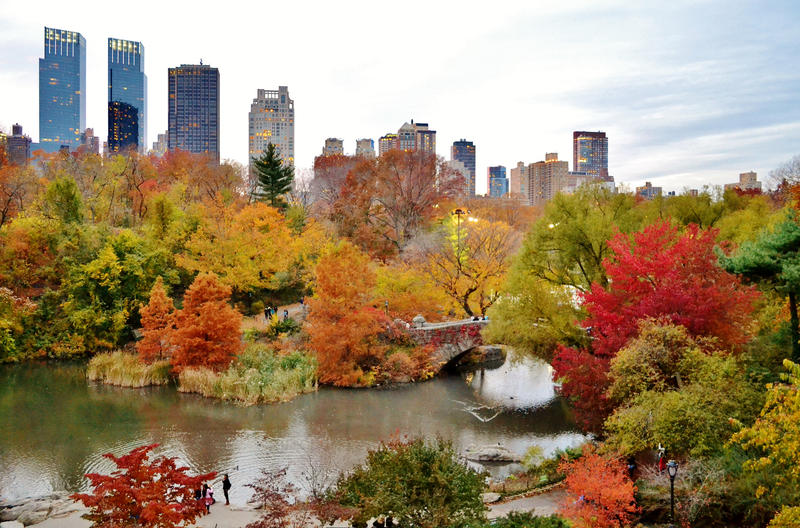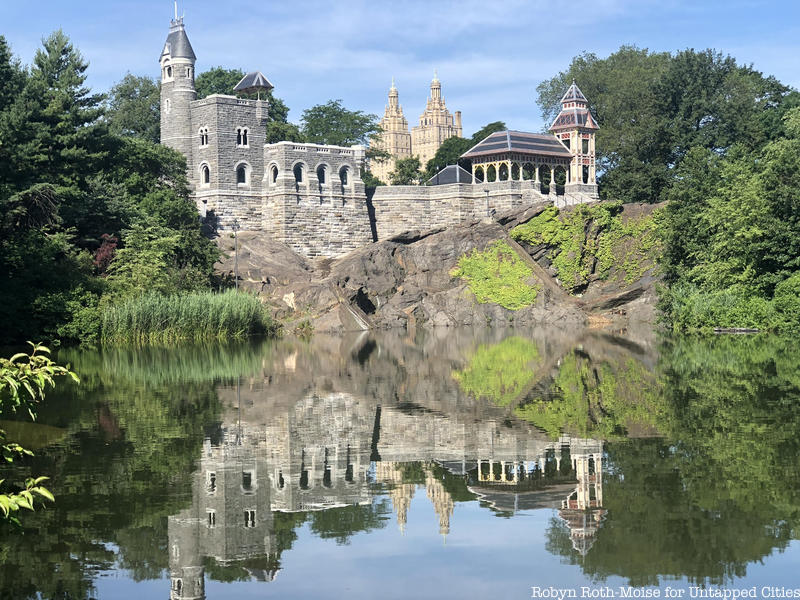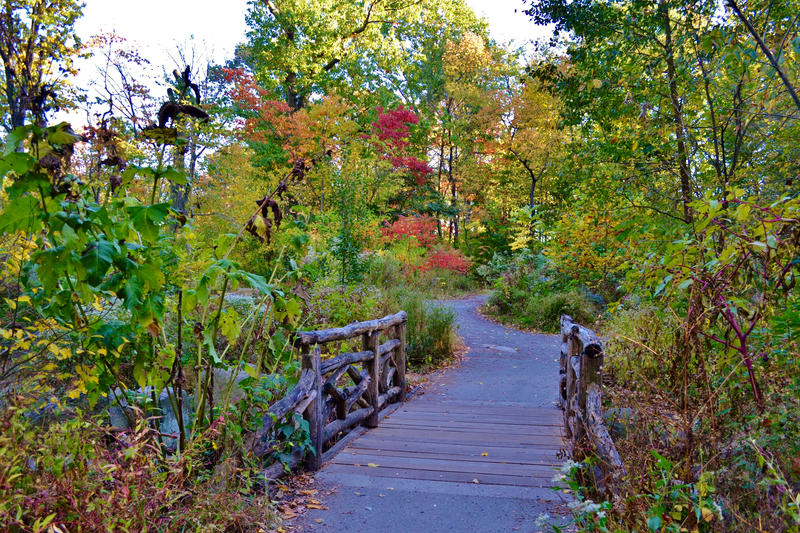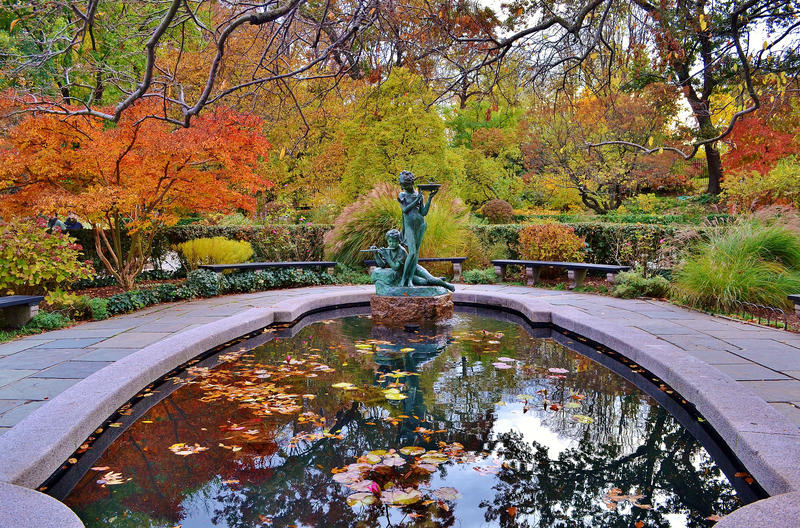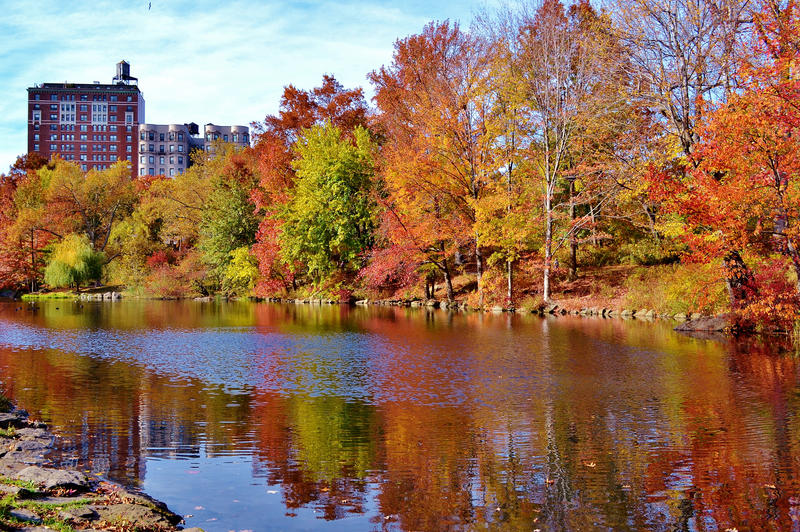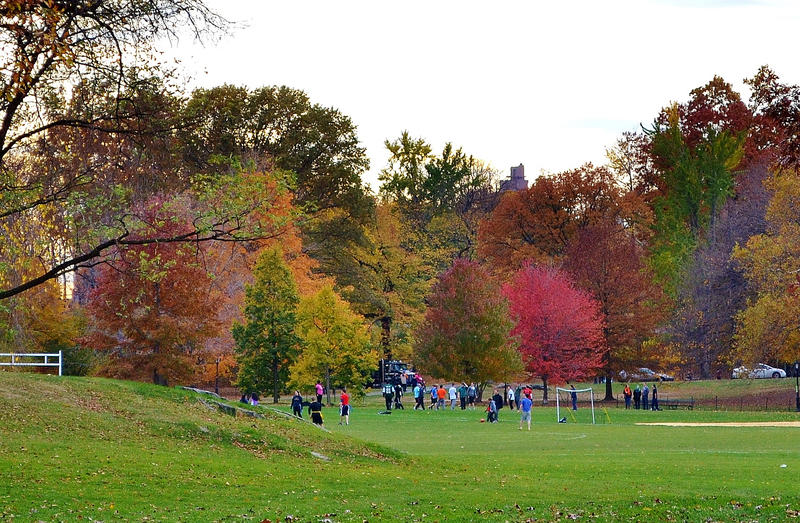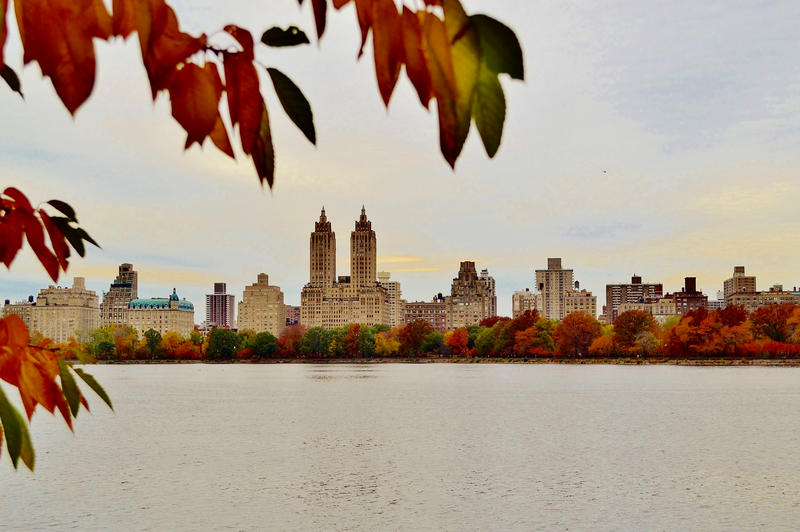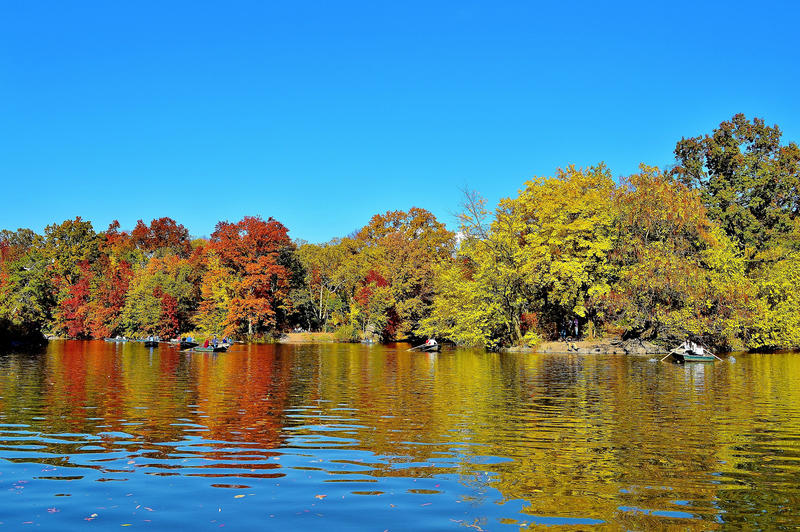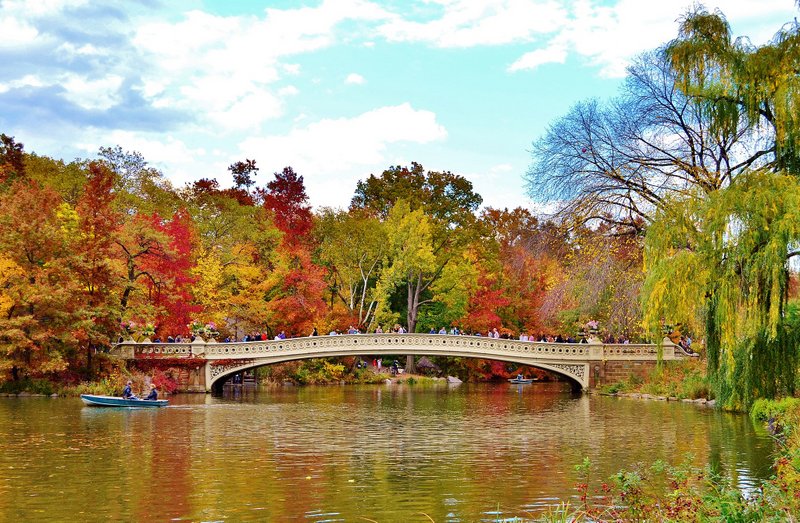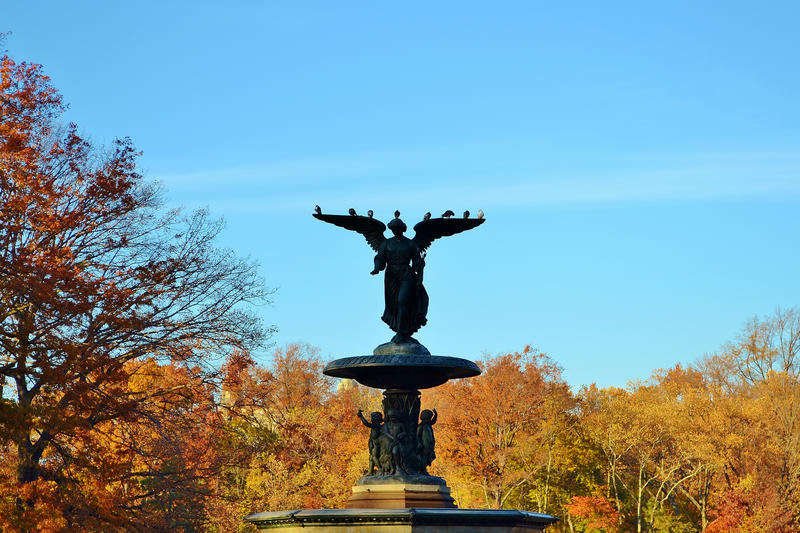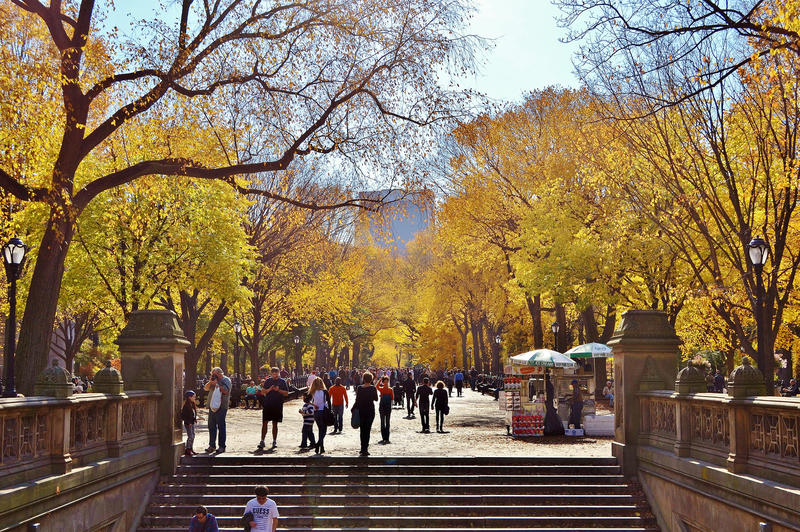Central Park is home to nearly 20,000 trees of different varieties including oak, elm, cherry, maple, and a host of others. As fall foliage starts to appear, the leaves of those trees take on rich and vibrant autumnal colors, making Central Park a must-visit leaf-peeping destination you can get to without leaving New York City. The Central Park Conservancy has an official map that highlights the most colorful spots in the park, along with an interactive map that tracks foliage status. Including suggestions from the Conservancy’s map, and with the addition of some of our favorites, from north to south, here are the top 10 places to see fall foliage in Central Park:
Join us for an upcoming Untapped Central Park tour to take in the colors of the fall firsthand!
10. The North Woods
Populated by Black Cherry, Pin, Red and Scarlet Oaks, Red Maple, and American Elm trees, The North Woods will be full of shades of red when the leaves turn. The American Elm’s leaves will turn yellow, as will some of the leaves on the Black Cherries and Red Oaks, while the Maples, and Pin and Scarlet Oak trees will turn shades of red, russet, bronze, and brown.
Stretching from the west side to mid-park from 101st to 110th Street, the North Woods is one of three woodland areas in Central Park. The two other woodland areas are the Ramble and Hallett Nature Sanctuary. As you stroll beneath the colorful branches of the North Woods, you can see other attractions such as the Glen Span Arch, the Ravine, and Loch.
9. Conservatory Garden
The six-acres of formals gardens inside the Conservatory Garden are just as bright and colorful in the fall as they are in the spring. During the autumn season the garden’s crabapple allees turn reddish-orange and there is a beautiful chrysanthemum display. The garden’s Stewartia trees take on hues of orange, red, and purple while the Star Magnolias turn yellow and bronze. The garden is located on the east side from 104th to 106th Street.
In addition to beautiful fall foliage, the Conservatory Garden is also full of history. This area of the park gets its name from a giant glass conservatory that stood on the site from 1898 to 1934. Landscape architect Gilmore D. Clarke transformed the site, bringing in elements of French, Italian, and English gardens, and opened it to the public in 1939. The entrance of the garden is through a giant iron gate that once stood at the entrance to Cornelius Vanderbilt II’s Fifth Avenue mansion. As an officially designated quiet zone, the conservatory is the perfect place for a peaceful retreat on a crisp autumn day.
8. The Pool
The Red Maple, Hickory, Tupelo, Bald Cypress, Willows, and Sugar Maple trees that line the Pool put on a vibrant display of colors for park-goers during the fall season. With shades of scarlet, yellow, red and orange, the Pool is a fantastic place to take in the colors of the season. As well as being one of the best spots to catch a glimpse of stunning foliage, the Pool’s proximity to the North Woods also makes it fertile ground for wildlife. Keep your eyes out for turtles, various birds, and fish. You can find the Pool on the west side of the park from 100th to 103rd Street.
7. North Meadow
According to the Central Park Conservancy’s foliage report, at the time of this writing, the North Meadow is at peak foliage! The expansive North Meadow, the largest open meadow in the park, is twenty-three acres of lawn, rocky outcrops, and hills that stretch from 102nd to 97th street. It is here that visitors will find the park’s seven baseball fields, five softball fields, and six seasonal soccer/touch football fields.
Tress you’ll find in this area include Hickory, Sugar Maple, and Flowering Dogwoods. As the season progresses the hickory and maple leaves will turn shades of autumnal oranges, reds, and yellows while the leaves of the Flowering Dogwoods will turn maroon and purple.
6. The Reservoir
The Central Park Reservoir, which was built as a temporary water supply in the 1860s, is one of the best places to see fall foliage. The Kwanzan Cherry trees that line the west side turn bronze and red in the fall while the Yoshino Cherry trees that line the east side change to yellow. The cherry trees found along the reservoir were gifts from Japan, sent over in 1912. Trees included in this special delivery were dispereed throughout the city, including areas like Riverside Park.
In the fall, the cherry trees in Central Park provide a lovely sight to see as you run or walk the 1.58-mile track that loops around the Reservoir. The Reservoir is forty feet deep and nearly spans the entire width of the park from 85th Street to 96th Street.
5. The Ramble
The Ramble is thirty-six acres of what Central Park’s landscape architect Frederick Law Olmsted called “wild gardens,” stretching from 73rd to 79th Street in the center of the park. This area is dotted with Red Oak, Sweet Gum, Pin Oak, Sassafras, Red Maple, Black Cherry, and Tupelo trees.
When the leaves of these trees start to turn they cover the entire autumnal color palette, from red and orange, scarlet and yellow to bronze and purple. While you’re there, don’t forget to stop by the Black Tupelo, one of Central Park’s “Great Trees.” Walking straight from the northwest entrance of the Ramble you’ll come upon the Tupelo Meadow to your right. About halway across you’ll find the Black Tupelo. With it’s bright red leaves that stand out from the surrounding greenery, you won’t miss it!
4. The Lake
The fiery colors of Central Park’s trees in the fall enhance the romanticism of the park and there are few spots more romantic than Bow Bridge at the Lake. The reflective nature of the water paired with the colors of the foliage and the iconic bridge are sure to make for a stunning sight. At twenty acres, the Lake is the largest naturalistic body of water in the park. Bow Bridge, which spans the Lake, serves as a pedestrian crossing that connects the Ramble to a path towards another iconic Central Park location, Bethesda Terrace.
3. Bethesda Terrace
At Bethesda Terrace, you can see one of New York City’s most iconic features set against the best foliage in the city. The Bethesda Fountain, topped by the Angel of Waters – a figure that commemorates the Croton water system that first provided water to the city in the 19th century – was the only statue commissioned for the park.
The creation Bethesda Fountain was a group effort. Sculptor Emma Stebbins became the first woman to receive a commission for a major public work in New York City when she was hired to design the twenty-six foot high fountain. The base of the fountain was designed by landscape architect Calvert Vaux, with ornamentation by Jacob Wrey Mould. Today, the result of their efforts can be admired while set against a backdrop of glowing fall foliage.
2. The Mall
The Mall runs through the middle of the park from 72nd to 66th street and is the park’s widest pedestrian pathway. This pathway is lined with rows of American Elms, one of the largest remaining arrangements of elms left in the country. In the fall, the leaves of these American Elms turn a glowing yellow. According to the Central Park Conservancy’s foliage report, at the time of this writing, the Mall is at peak foliage! Discounting the Conservatory Garden, the Mall is the only formal feature in the park’s naturalistic design and the only intentional straight line inside the park. The path of the mall leads to the Bethesda Fountain.
1. The Pond
One of the seven bodies of water in Central Park, the Pond can be found near Central Park South between Fifth and Sixth Avenues. The Black Cherry, Sawtooth Oak, Gray Birch and Tupelo trees that surround the pond provide a colorful backdrop for the fairytale-like, stone Gapstow Bridge and the ducks that swim in the pond.
Don’t wait until the colors have faded! Head out to Central Park to take in the wide spectrum of fall colors that surround its natural features and iconic architectural elements.
Next, check out 10 Historic Ruins and Remnants Inside NYC’s Central Park






